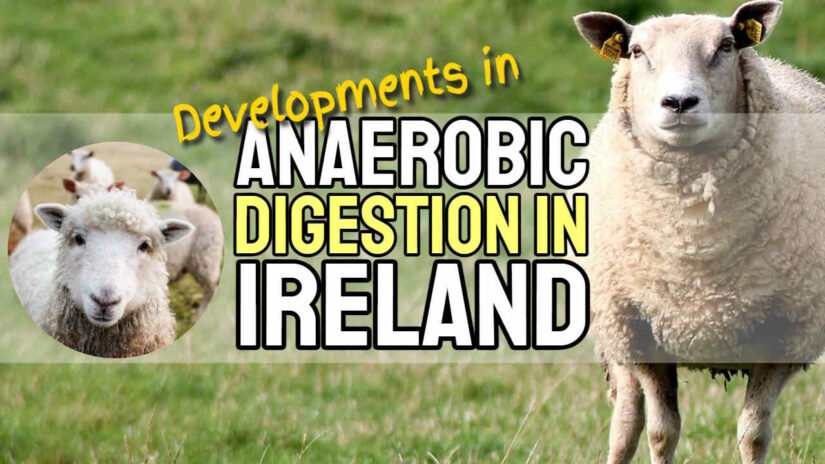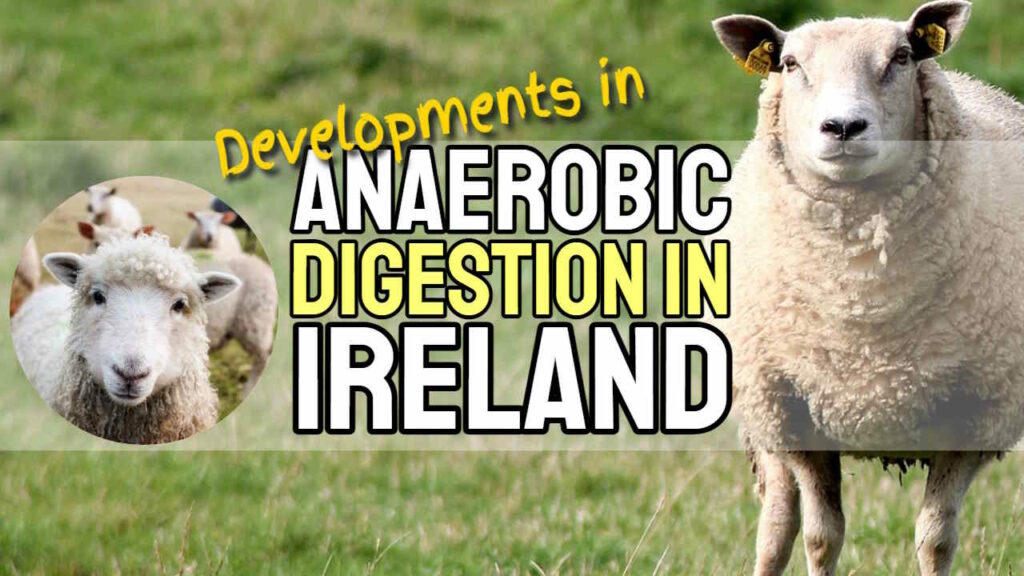There is a rising rate of the development of anaerobic digestion in Ireland (the Irish Republic). Although a number of commentators have suggested that progress in this technology in the Republic has been disappointing, there is progress in the construction of new biogas plants, despite very difficult economic conditions for investment.

Anaerobic Digestion in Ireland – Current Status and Challenges
1. Biomethane production in the Republic of Ireland: Current status and challenges
Biomethane production is an emerging technology in Ireland that has the potential to reduce greenhouse gas emissions and increase energy security.
The southern region of Ireland has become a hub for biomethane production due to its favourable climate and agricultural resources. However, despite the region's potential, the current status of biomethane production in Ireland south of the border is still in its early stages.
Challenges such as low feedstock availability, high capital costs, and lack of policy support are hindering the growth of the industry. To overcome these challenges, stakeholders in the biomethane industry in Ireland south of the border need to work together to develop a comprehensive strategy that includes increasing the availability of feedstock, reducing capital costs, and advocating for policy support.
Collaboration between farmers, industry leaders, and government officials is essential to developing a sustainable and profitable biomethane industry in the region. Despite the challenges, there are opportunities for biomethane production in Ireland south of the border.
The increasing demand for renewable energy and the potential for export markets make biomethane an attractive investment opportunity.
With the right strategy and collaboration, Ireland south of the border can become a leader in biomethane production, contributing to the country's renewable energy goals and reducing greenhouse gas emissions.

2. The role of biomethane in Ireland's transition to renewable energy
The Republic of Ireland has set an ambitious target to reduce its greenhouse gas emissions by 50% by 2030, with a long-term goal of achieving carbon neutrality by 2050. To achieve this, the country is transitioning to a more sustainable and renewable energy system.
Biomethane, also known as renewable natural gas, is one of the key players in this transition. Biomethane is a type of renewable gas produced from organic material, such as food waste or agricultural crops, through a process called anaerobic digestion. It is a carbon-neutral source of energy and can be used in the same way as conventional natural gas.
Furthermore, it can be injected into the natural gas grid, providing a readily available source of renewable gas to households and industries. Ireland has already made significant progress in biomethane production, with several biomethane injection projects already in operation. These projects are expected to produce enough biomethane to replace up to 20% of Ireland's natural gas demand. In addition, the Irish government has announced the development of a national biomethane support scheme, which will provide financial support to biomethane producers. The role of biomethane in Ireland's transition to renewable energy is significant. It offers a sustainable solution to reducing the country's dependence on fossil fuels and helps to decrease greenhouse gas emissions. Biomethane production also presents additional benefits, such as the reduction of food waste and the creation of renewable energy jobs. As Ireland moves towards a cleaner and more sustainable energy system, biomethane has a crucial role to play.
3. The potential of circular bioeconomy in Ireland
The circular bioeconomy has the potential to revolutionize Ireland's economy, both environmentally and financially. With the country's focus on sustainability and renewable resources, the circular bioeconomy aligns perfectly with Ireland's goals.
The circular bioeconomy aims to turn waste and by-products from agriculture, forestry, and fisheries into valuable resources that can be used for multiple purposes.
This process requires the use of innovative technologies and processes, which can create new jobs and business opportunities while reducing waste and greenhouse gas emissions. Ireland is well-positioned to develop circular bioeconomy initiatives due to its strong agricultural sector, extensive forestry resources, and coastal fishing communities.
The potential to produce high-value products from biomass such as bioplastics, biofuels, and biorefineries is vast, and the circular bioeconomy can also provide new income streams for farmers and local communities. Furthermore, the circular bioeconomy can reduce Ireland's reliance on imported fossil fuels and provide a sustainable alternative.
To realize the full potential of the circular bioeconomy in Ireland, it is important to invest in research and development, innovation, and education. Collaboration between government agencies, industry, and academic institutions is crucial to develop effective strategies and policies that promote the circular bioeconomy.
Additionally, consumer awareness and education programs can help promote the benefits of circular bioeconomy products and encourage their use.
The potential of a circular bioeconomy in Ireland is significant, and with the right investments and support, it can lead to a more sustainable, prosperous, and environmentally friendly future for the country.
4. Sustainable agriculture and biomethane production in Ireland
Ireland is a country that has made significant strides over the years to adopt environmentally sustainable practices, particularly in the agricultural sector. Sustainable agriculture refers to the use of farming practices that do not deplete natural resources or harm the environment, while still ensuring that the needs of the present and future generations are met.
The implementation of sustainable agriculture has been a major priority in Ireland due to the significant impact that the agricultural sector has on the environment and the country's economy. One of the ways that Ireland has demonstrated its commitment to sustainable agriculture is through the production of biomethane.
Biomethane is a renewable energy source that is derived from organic waste. The production of biomethane helps to reduce carbon emissions and contributes to the country's goal of achieving net-zero emissions by 2050.
Ireland has made significant investments in the development of biomethane production plants, which have the potential to generate significant quantities of renewable energy. In conclusion, sustainable agriculture and biomethane production in Ireland are key priorities for the country as it seeks to reduce its carbon footprint while ensuring food security for its citizens.
The adoption of sustainable agricultural practices has the potential to achieve both of these objectives simultaneously. With the continued investment in biomethane production plants, Ireland is well on its way to transitioning its energy sector from fossil fuels to renewable sources, thus contributing to the global fight against climate change.
5. Biomethane vs natural gas: A comparative analysis of cost and environmental impact
Biomethane and natural gas are two popular energy sources that have been extensively used in various industries for decades.
However, with the growing concern for environmental sustainability and the need to reduce greenhouse gas emissions, there has been a renewed interest in the use of biomethane as a cleaner and more efficient energy source. This has prompted a comparative analysis of the cost and environmental impact of biomethane and natural gas.
One of the key advantages of biomethane is its renewable nature, as it is produced from organic waste streams such as agricultural and food waste. This means that it has a significantly lower carbon footprint when compared to natural gas, which is obtained from fossil fuel sources. Biomethane when ready for grid injection has the same energy density as natural gas, meaning that it provides the same energy per unit volume.
On the other hand, natural gas has been widely used as a primary energy source due to its low cost and availability. However, its extraction and transportation can result in significant greenhouse gas emissions, leading to environmental concerns. When comparing the cost of biomethane and natural gas, the former is generally more expensive due to the production process involved.
However, this cost may be offset by the potential revenue generated from the sale of renewable energy credits. In conclusion, while biomethane and natural gas both have their advantages and disadvantages, the former appears to be a more sustainable and environmentally friendly option. As such, it is becoming an increasingly popular choice for businesses and industries looking to transition towards a more sustainable future.
6. Addressing Ireland's energy security through biomethane production
Ireland's energy security has become an increasingly important topic in recent years, as the country aims to reduce its reliance on imported fossil fuels and move towards a more sustainable energy system. One promising solution to this challenge is the production of biomethane. Biomethane is a renewable gas that can be produced from organic waste sources, such as agricultural residues, food waste, and sewage sludge.
When purified, it can be used as a direct replacement for natural gas, which currently accounts for over 60% of Ireland's energy consumption. Biomethane production offers a range of benefits for Ireland's energy security.
Firstly, it can help to reduce the country's greenhouse gas emissions by diverting organic waste from landfill and preventing it from releasing methane, a potent greenhouse gas, into the atmosphere.
Secondly, it can create a local, decentralised source of energy that is less vulnerable to supply disruptions, compared to imported fossil fuels. Finally, biomethane production can support the development of a circular economy, where waste is viewed as a valuable resource, rather than a burden.
To fully realise the potential of biomethane production in Ireland, more investment is needed in infrastructure, such as anaerobic digestion plants and gas pipelines. There is also a need for supportive policy frameworks, including incentives for biomethane producers and a carbon pricing mechanism that reflects the true social and environmental costs of fossil fuels.
By addressing these challenges, Ireland can become a leader in sustainable energy and enhance its energy security for future generations.
7. Future outlook for biomethane in Ireland's energy mix
The potential of biomethane as a renewable energy source in Ireland's energy mix has been gaining more attention in recent years. Biomethane is produced from organic waste material and agricultural residues through a process called anaerobic digestion. It is considered a low-carbon energy source and has the potential to contribute significantly to Ireland's climate action targets.
The Irish government has set an ambitious target of reducing greenhouse gas emissions by 51% by 2030. Biomethane has been identified as one of the key technologies to help achieve this target. The Irish government has allocated funding for the development of biomethane production plants, and existing anaerobic digestion plants are being upgraded to produce biomethane for injection into the gas grid.
The potential for biomethane in Ireland's energy mix is significant, with estimates suggesting it could contribute up to 28% of the country's gas needs by 2050. This would provide a sustainable and reliable source of energy and reduce Ireland's dependency on imported fossil fuels.
However, there are still some challenges to overcome, such as ensuring a secure supply of feedstock and developing a robust regulatory framework for biomethane production. Nevertheless, the future outlook for biomethane in Ireland's energy mix is positive, and it has the potential to play a significant role in Ireland's transition to a low-carbon economy.
8. How policy changes can drive growth in the biomethane industry
Policy changes play a crucial role in driving growth within the biomethane industry. As a clean and renewable energy source, biomethane has the potential to significantly reduce greenhouse gas emissions and support energy security. Therefore, the implementation of policies that incentivize the production and utilization of biomethane can encourage investment and innovation in the industry.
One such policy change that can drive growth in the biomethane industry is the introduction of feed-in tariffs. Feed-in tariffs are mechanisms that offer guaranteed prices for the renewable electricity fed into the grid from biomethane plants, encouraging investment in large-scale production facilities.
Another policy change that can drive growth in the biomethane industry is the introduction of carbon pricing. Carbon pricing would place a monetary value on greenhouse gas emissions, creating a financial incentive for the production of clean energy such as biomethane. Moreover, carbon pricing can encourage the establishment of biomethane export markets, especially in countries with ambitious climate targets.
Lastly, policy changes that encourage the use of biomethane in transportation can also drive growth in the industry. This can be achieved through the provision of tax incentives, grants, or subsidies that make biomethane a competitive alternative to fossil fuels. In conclusion, policy changes that incentivize investment and utilization of biomethane can drive growth in the industry while contributing to a more sustainable future.
9. Opportunities and benefits of investing in the Irish biomethane sector
Investing in the Irish biomethane sector has become an attractive proposition for many investors due to the numerous opportunities and benefits it offers. The sector has seen significant growth in recent years, driven by increasing demand for renewable energy and the Irish government's focus on achieving its ambitious climate change targets.
The development of biomethane facilities presents a unique opportunity for investors to contribute to the transition towards a low-carbon economy. Investing in the Irish biomethane sector provides a wealth of benefits. Firstly, it allows investors to diversify their portfolios by investing in a sustainable, long-term asset that offers regular income streams.
Additionally, it offers investors the opportunity to make a positive impact on the environment, by replacing fossil fuels with renewable energy sources. Furthermore, the sector benefits from a stable regulatory framework, offering investors certainty and predictability, which is crucial for long-term planning and investment. The Irish government has introduced a range of support mechanisms for the biomethane sector, including grant funding and feed-in tariff schemes, which provide investors with further incentives to invest in the sector.
The sector also benefits from a skilled workforce and advanced research and development capabilities, ensuring that biomethane technology remains at the forefront of renewable energy technology. In summary, investing in the Irish biomethane sector offers significant opportunities and benefits to investors.
Not only does it provide a sustainable, long-term asset with regular income streams, but it also contributes to the transition towards a low-carbon economy and offers a positive impact on the environment. With a stable regulatory framework and a range of support mechanisms, the biomethane sector in Ireland can present an attractive investment proposition for investors.
10. Financing options for biomethane projects in Ireland
Biomethane production is increasing in popularity in Ireland, and with that comes a need for financing options. Fortunately, there are several viable options available for those looking to finance these projects.
One option is the European Investment Bank, which can provide loans and guarantees for projects that meet specific criteria. Another option is the Department of Communications, Climate Action and Environment, which offers grants for biomethane projects that meet their requirements.
Additionally, the Renewable Gas Forum Ireland has established a financing task group to explore and recommend financing options for biomethane projects. This group includes representatives from industry, finance, and government agencies.
They have identified three main financing models: self-financing, where the project owner uses their own capital to fund the project; third-party financing, where a bank or other financial institution provides funding for the project; and project financing, where the project is financed by a group of investors who share the risks and rewards of the project.
Each financing model has its own advantages and disadvantages, and careful consideration should be given to which option is best suited for each individual project. Overall, the financing options for biomethane projects in Ireland are varied and accessible, making it possible for investors to participate in this growing industry.
Where you looking for Anaerobic Digestion in Northern Ireland?



Awesome Work. I find Irish AD websites are all just contractor’s business websites, so where can I get impartial reviews of Irish biogas plant contractor’s? Like your website and also good styling.
Designer – I’m not sure about getting impartial reviews, but right around the world, a good starting-point is to seek out Industry Trade Associations.
Generally, they provide a list of their members, and only genuine companies are accepted as members. Trade Associations can often be found by doing a Google search something like “industry” “trade association” “country”.
Googling “anaerobic digestion Trade Association Ireland” just now, gave me:
Irish BioEnergy Association: IrBEA
Anaerobic Digestion & Bioresources Association (ADBA)
World Biogas Association
and for the biogas industry:
REA Biogas – trade association for the Anaerobic Digestion and Biogas industry in the UK
Gary – Thanks for your amazing feedback This is certainly the first time I’ve been told; “He in actual fact purchased me breakfast because I found it for him”, about any web page I ever produced before! WONDERFUL!! Thanks for sharing this with us.
I just added this website to a new fresh list of links or ours. I hope all of you are looking forward to taking the biogas industry into the post-Brexit future. (What ever that might mean…) Now it’s time to get back to work.
My appreciation. Trust Ireland, a land I love, to be slow to uptake on this tech. Ireland you truly act to form. When the Irish get going they will be world beaters. Mark what I say. Thanks for presenting this useful, article to the www.
1.6 Million Pigs in the Republic of Ireland surely there is a market. I also heard of a cow methane backpack from Argentina. What if using the CH4 (Gas) as a fuel for electricity and scrubbing the C02 with a combustion scrubber called monoethanolamine installed by an expert, then using the scrubbed CO CO2 (Carbon Dioxide and Carbon Monoxide) at the Fire Station for fire fighting electrical fires. Methane could power a tractor harvesting beans or berries. I like beetroot drinks and beetroot.
Peter – Yes. Pig manure is a good feedstock I am sure. I have not heard of that scrubber, but there are many ways to scrub CO2. Using the carbon dioxide separated from raw biogas for fire fighting sounds like a good use for it. We posted an article about methane powered tractors a few years ago here.
I’m really inspired with your knowledge. I notice there are links provided as well, and these also help follow up on my research. Are you not worried by the connections with big food industry interests in NI?